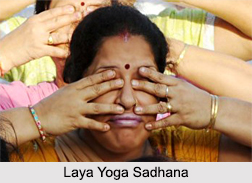 Laya Yoga Sadhana is a form of meditation in Kundalini Yoga that aims at achieving mukti or liberation of soul. Laya Yoga is an integral stage of Kundalini meditation and particular steps are followed to achieve the goal of Laya Yoga Sadhana.
Laya Yoga Sadhana is a form of meditation in Kundalini Yoga that aims at achieving mukti or liberation of soul. Laya Yoga is an integral stage of Kundalini meditation and particular steps are followed to achieve the goal of Laya Yoga Sadhana.
The first step to carry out Laya Yoga Sadhana is to sit on padma or siddha asana and the practice of the yoni mudra by closing the ears with the thumbs. The yogi should hear the internal sound through the right ear. Thus having overcome all obstacles, one will enter the Turiya state within 15 days.
In the beginning of Laya Yoga Sadhana, one will hear many loud sounds. They gradually increase in pitch and are heard more and more delicately. The Yogi should try to distinguish sounds more and even more fainter. The person can change the modes of concentration from the gross sound to the subtle or from the subtle to the gross, but he should not allow his mind to be diverted from them towards other objects. The mind having at first concentrated itself on any one sound secures itself firmly to that and gets absorbed in it.
The mind of the Yogi eventually becomes insensible to the external impressions, merges with the sound as milk with water and eventually becomes rapidly absorbed in Chidakasa - the Akasha. Chidakasa is the space where Chitta and consciousness prevails. The sound proceeding from Pranava is Brahman and is of the nature of effulgence; the mind becomes deeply absorbed in it, which happens to be the supreme abode of Vishnu.
The mind exists so long as there is sound, but with its cessation, there is that state called the Turiya. This sound gets absorbed in Brahman and the mute state is the supreme seat. The mind which along with Pranava has its karmic similarities destroyed by the constant concentration upon Nada is absorbed in the Unstained One. Nada Yoga again has close resemblance with the stages of Laya Yoga Sadhana. Being freed from all states and all thoughts whatever, will transform the Yogi like a dead person. The ultimate possession after Laya Yoga Sadhana is to posses a mukta or liberated soul.




















